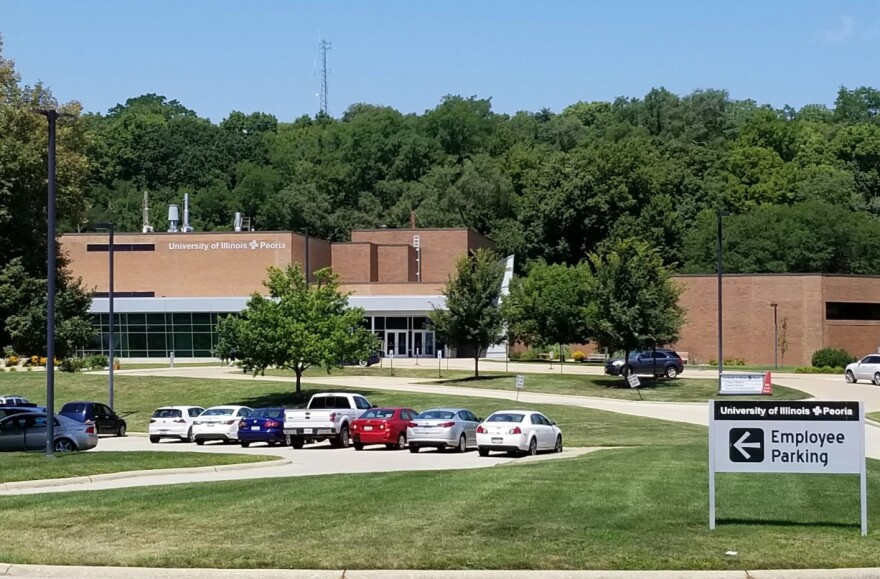A team of researchers at the University of Illinois College of Medicine Peoria is working to find a treatment to reduce brain damage suffered by stroke victims.
Ischemic stroke is among the most common causes of long-term disability and death. In 1996, the Food and Drug Administration (FDA) approved the use of a tissue-type plasminogen activator (tPA) to open blocked blood vessels in stroke victims.
Dr. Krishna Kumar Veeravalli hopes a three-year, $300,000 transformational project grant from the American Heart Association (AHA) will lead to the next major breakthrough.
“Despite decades of research, there is no drug that reduces the brain damage that occurs when there was a block, and the brain damage that occurs after removing the block. There is no drug,” said Veeravalli, an associate professor in the UICOMP Department of Cancer Biology and Pharmacology.

“We have a drug to remove the block, but we don't have any drug – despite 30-40 years of research – which can reduce the brain damage and improve the functional recovery,” Veeravalli said.
Veeravalli is leading a team of UICOMP researchers studying how to control a protein called MMP-12 that increases in the brain after a stroke. He said the research stems from a project that “started from zero” about eight years ago.
“In 2015, we published our first paper on MMP-12, a protein that is released from one of the types of blood cells that exacerbates – that means it contributes to the brain damage that occurs after stroke,” Veeravalli said. “So after that, we wanted to study how this molecule is causing brain damage.”
In 2018, Veeravalli’s project received a grant from the National Institutes of Health’s Institute of Neurological Disorders and Stroke that enabled a closer look at MMP-12.
“During this past five years, we worked on the grant and we found the molecular mechanisms through which this molecule (MMP-12) is creating the damage,” he said. “And we also found that when we inhibit this molecule, the functional recovery was also improved. So these are all preclinical studies, not clinical studies. Now our next step is to take our discoveries from bench to the bedside.”
Veeravalli said his team was able to inhibit MMP-12 by using what he called “gene-silencing technology.”
“But there are a lot of limitations to taking this kind of technology to humans," he said. "So we wanted to develop an antibody against this molecule and test it in the preclinical studies to see if these antibodies are good to reduce the brain damage. And if they are good, what is the best time to treat them? And what is the best dose? And how long we should treat?”
Now, Veeravalli and his team will use the AHA grant to advance the research. In collaboration with Dr. Adinarayana Kunamneni from the Mayo Clinic, the lab will make anti-MMP-12 antibodies and see how well they work.

“We will screen the best five antibodies and then we will test those five antibodies in our lab to see what is the best one,” Veeravalli said. “Once we know which is the best antibody, we will optimize the dose, we will optimize the timing of the treatment, and we will optimize the duration of the treatment for better results. In our case, better result means the brain damage has to be reduced and there should be improvement in the functional recovery.”
Veeravalli said the goal of their research is to discover antibodies that will help stroke victims get better faster.
“This is the first step. Developing an antibody is like a pharmaceutical company developing an inhibitor molecule or a drug molecule,” he said. “We found that this molecule is the bad guy, and we want to inhibit or suppress that bad guy. For that, we want to develop an antibody so that when we give this antibody, this antibody will go into the body and bind to that molecule and inhibit that molecule.”
Veeravalli said the next phase of research will serve as “proof of concept” studies.
“Once we've found the efficacious molecule and effective dose (and) optimal timing, this can lead to future safety studies – again, some pre-clinical studies,” he said. “Eventually, our goal is to take these antibodies to humans, to treat human patients with ischemic stroke. It may take several years, but this is the starting step towards that goal.”
Veeravalli hopes the treatment they develop will not only reduce brain damage and accelerate recovery, but also widen the window for receiving initial treatment. Currently, the tPA must be administered within 4½ hours of the first signs of a stroke.
“But it is only 3%-5%, on a national average, reach hospital in time to be considered for this treatment. If the patient is coming to the hospital after six hours of the symptoms, they're not eligible for this tPA treatment,” said Veeravalli, who noted patients with bleeding disorders also cannot receive tPA because it worsens the condition.
“We are hoping that our treatment will reduce the brain damage and improve recovery irrespective of tPA treatment," he said. "But we are also expecting that if we give this treatment along with the tPA treatment, it can reduce the toxicity associated with the tPA treatment and thereby it extends the time window of tPA treatment and making more patients eligible for that treatment. It will have a significant clinical impact.”


